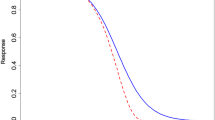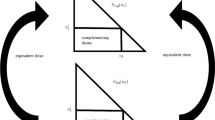Abstract
Analysis schemes for the classification of synergism and antagonism for mixed agents operate on the discrepancies between observed and calculated results. As such they cannot be confirmed by experiments and therefore have to be tested in terms of mathematical and logical self-consistency. The concept of independent action is close to the literal meaning of the term “non-interaction”. Since this concept does not depend on the mechanisms of actions nor on the type of effect scale used, it is suitable as one of the basic criterion for the definition of synergism and antagonism. A general mathematical framework of independent action is presented in this paper based on the concept of “relative effect” as used in the literature. The, different equations for independent action currently used in various areas are shown to be manifestations, of a general formula under different sets of boundary conditions, which are the natural limiting values of the effects of the corresponding system observed at low and at high doses of the agents. The framework can, be generalized to the combined action ofn-agents as well as to the interaction of an agent with itself. In addition, the differential form of the formula for independent action is derived. This framework of systematic definitions and derived equations enable a more in-depth study of the implications of the concept of independent action and its relation to other concepts of non-interaction.
Similar content being viewed by others
Literature
Ashford, J. R. 1958. Quantal responses to mixtures of poisons under conditions of simple similar action—the analysis of uncontrolled data.Biometrika 45, 74–88.
Ashford, J. R. and C. S. Smith. 1964. General models for quantal response to the joint action of a mixture of drugs.Biometrika 51, 413–428.
Berenbaum, M. C. 1985. The expected effect of a combination of agents: the general solution.J. theor. Biol. 114, 413–431.
Berenbaum, M. C. 1989. What is synergy?Pharmacol. Rev. 1989, 93–141.
Bliss, C. I. 1939. The toxicity of poisons applied jointly.Ann. Appl. Biol. 26, 585–615.
Chadwick, K. H. and H. P. Leenhouts. 1981.The Molecular Theory of Radiation Biology. New York: Springer-Verlag.
Connell, E. V., R. L. Cerruti and P. W. Trown. 1985. Synergistic activity of combinations of recombinant human alpha interfereon and acyclovir, administered concomitantly and in sequence, against a lethal herpes simplex virus type 1 infection in mice.Antimicrob. Ag. Chemother.28, 1–4.
Dewey, W. C. 1979.In vitro systems: standardization of endpoints.Int. J. Radiat. Oncol. Biol. Phys. 5, 1165–1174.
Drury, R. E. 1980. Physiological interaction, its mathematical expression.Weed. Sci. 28, 573–579.
Fowler, J. F., K. Kragt R. Ellis, P. J. Lindop and R. J. Berry. 1965. The effect of divided doses of 15 MeV electrons on the skin response of mice.Int. J. Radiat. Biol. 9, 241–252.
Hewlett, P. S. 1969. Measurement of the potencies of drug mixtures.Biometrics 25, 477–487.
Hewlett, P. S. and R. L. Plackett. 1959. A unified theory for quantal responses to mixtures of drugs: non-interactive action.Biometrics 15, 691–610.
Hill, C. K., F. J. Buonoguro, C. P. Myers, A. Han and M. M. Elkind, 1982. Fission-spectrum neutrons at reduced dose rate enhance neoplastic transformation.Nature 298, 67–68.
Kellerer, A. M. and H. H. Rossi, 1972. The theory of dual radiation action.Curr. T. Radiat. Res. Q. 8, 85–158.
Maisin, J. R., L. De Saint-Georges, M. Janowski, M. Lambiet-Collier and G. Mattelin. 1987. Effect of X-rays alone or combined with diethylnitrosamine on cancer induction in mouse liver.Int. J. Radiat. Biol. 51, 1049–1057.
Plackett, R. L. and P. S. Hewlett. 1948. Statistical aspects of the independent joint action of poisons, particularly insecticides I. The toxicity of a mixture of poisons.Ann. Appl. Biol. 35, 347–358.
Plackett, R. L. and P. S. Hewlett. 1952. Quantal responses to mixtures of poisons.J. Royal Stat. S. B14, 141–163.
Pöch, G. 1991. Evaluation of combined effects with respect to independent action.ACES 3, 65–74.
Pöch, G. 1993.Combined Effects of Drugs and Toxic Agents—Modern Evaluation in Theory and Practice. Vienna: Springer-Verlag.
Prichard, M. N. and C. Shipman, Jr. 1990. A three-dimensional model to analyze drug-drug interactions.Antiviral Res. 14, 181–206.
Rahal, J. J. Jr. 1978. Antibiotic combinations: The clinical relevance of synergy and antagonism.Medicine 57, 179–195.
Rideout, R. C. and T-C. Chou. 1991. Synergism, antagosism, and potentiation in chemotherapy: an overview. InSynergism and Antagonism in Chemotherapy, T-C Chou and D. C. Rideout (Eds), pp. 3–60. San Diego: Academic Press.
Rothman, K. J. 1974. Synergy and antagonism in cause-effect relationships.Amer. J. Epidemiol. 99, 385–388.
Steel, G. G. 1979. Terminology in the description of drug-radiation interactions.Int. J. Radiat. Oncol. Biol. Phys. 5, 1145–1150.
Suhnel, J. 1990. Evaluation of synergism or antagonism for the combined action of antiviral agents.Antiviral Res.13, 23–40.
Tyrrell, R. M. 1978. Radiation synergism and antagonism.Photochem. Photobiol. Rev. 3, 35–113.
Unkelbach, H.-D. and G. Pöch. 1988. Comparison of independence and additivity in drug combinations.Arzneim.-Forsch./Drub. Res. 38, 1–6.
United Nations Scientific Committee on the Effects of Atomic Radiation (UNSCEAR). 1982.Ionizing Radiation: Sources and Biological Effects. See Annex L, p. 736. New York: United Nations Publications.
Veckenstedt, A., J. Guttner and I. Beladi. 1987. Synergistic action of quercetin and murine alpha/beta interferon in the treatment of Mengo virus infection in mice.Antiviral Res 7, 169–178.
Webb, J. L. 1963. Effect of more than one inhibitor. InEnzyme and Metabolic Inhibitors, Vol. 1, pp. 66–79, 488–512, New York: Academic Press.
Author information
Authors and Affiliations
Rights and permissions
About this article
Cite this article
Lam, G.K.Y. A general formulation of the concept of independent action for the combined effects of agents. Bltn Mathcal Biology 56, 959–980 (1994). https://doi.org/10.1007/BF02458276
Received:
Revised:
Issue Date:
DOI: https://doi.org/10.1007/BF02458276




